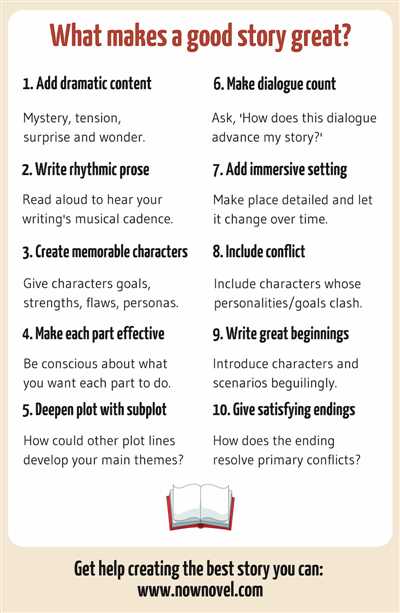
Writing a drama story can be an exciting and challenging activity for any writer. Whether you’re a novelist, a playwright, or just someone who enjoys writing, there are strategies you can use to successfully create a dramatic story that will captivate your readers and leave them wanting more.
One of the first things you should do when writing a drama story is to choose a genre that appeals to you. There are many different genres of drama, from romance to mystery to suspense, so find one that interests you and go from there. Once you’ve chosen a genre, think about the characters you want to include in your story. Develop their lives, their backgrounds, and their motivations, having a strong sense of who they are and what they want will make your story more intriguing and realistic.
Another important aspect to consider when writing a drama story is the point of view (POV) you want to use. You can choose to write from a first-person perspective, where the story is told directly through the eyes of one character, or you can write from a third-person perspective, where the narrator is separate from the characters. Both approaches have their merits, so it’s up to you to decide which one works best for your story.
To make your drama story more engaging, it’s essential to show, not tell. Instead of simply telling your readers what is happening, show it to them through the actions and dialogue of your characters. This will create a stronger emotional impact and allow your readers to become more invested in the story. Additionally, consider using dialogue to reveal information and advance the plot. Conversations between characters can be a powerful tool in developing relationships, building tension, and revealing key information.
In order to keep your readers hooked, it’s important to have a good mix of action and introspection in your story. While dramatic events and conflicts are essential to move the story forward, it’s also important to give your characters moments of reflection and self-discovery. This allows readers to connect with the characters on a deeper level and adds depth to your narrative. Striking a balance between these moments will keep your readers engaged and eager to turn the page.
Lastly, don’t be afraid to take risks and experiment with different storytelling techniques. Engaging your readers with unexpected twists and turns, unusual narrative structures, or unconventional characters can make your drama story stand out from the rest. Remember, what’s most important is that you stay true to your creative vision and make the story uniquely yours.
So, whether you’re a seasoned writer or just starting out, follow these tips and strategies to write a drama story that will keep your readers on the edge of their seats. With a good mix of compelling characters, intriguing plot twists, and skillful storytelling, you can craft a drama story that will leave a lasting impression on your audience.
- From drama strategies into writing
- 1. Show, don’t tell
- 2. Choose the right point of view
- 6 Tips on how to successfully write drama series
- Mix dramatic point of view with other POVs
- Why mix POVs in a drama story?
- How to mix POVs successfully?
- Video:
- This Is How To Develop A Story Using The 36 Dramatic Situations – Jeff Kitchen
From drama strategies into writing
Writing a drama story involves more than just putting words on a page. It requires a writer to have creative ideas and thought-provoking strategies to capture the attention of readers. But what’s the secret to creating an intriguing drama story? Let’s take a look at how drama strategies can be successfully translated into writing.
1. Show, don’t tell
One of the most important tips for writing a drama story is to show the emotions and actions of characters rather than telling the readers about them. Instead of saying “Tom was sad,” show Tom’s slumped shoulders, teary eyes, and heavy sighs. This allows readers to connect with the character and create a deeper emotional impact.
2. Choose the right point of view
The point of view (POV) you choose for your drama story can greatly impact how the readers experience the plot. You can choose to write from multiple POVs to give insight into different characters’ lives or opt for a single POV to maintain a sense of mystery. Experiment with different POV styles to find the one that best fits your story’s genre and tone.
When writing a drama story, it’s essential to mix intense and dramatic moments with quieter, introspective scenes. This creates a dynamic flow and keeps readers engaged throughout the story. By alternating between high-tension moments and more reflective spaces, you can build suspense and create an enjoyable reading experience.
3. Develop intriguing characters
Good drama stories always have well-developed and complex characters. Spend time crafting unique backgrounds and motivations for each character, making them feel more authentic and relatable. Give them flaws and challenges to overcome, and show their growth and transformation throughout the story. The more depth your characters have, the more invested your readers will be in their lives and the overall plot.
4. Use dialogue effectively
Dramatic dialogue is essential in a drama story. Use dialogue to reveal information, show conflicts, and build tension between characters. Make sure the dialogue sounds natural and authentic to each character’s voice. Avoid unnecessary exposition and aim for conversations that are both engaging and realistic.
5. Show, don’t tell
Always remember that drama stories are about showing, not telling. Instead of telling readers that the character is angry, show their clenched fists or the redness in their face. Instead of telling readers that a relationship is falling apart, show the characters distancing themselves and having arguments. This allows readers to connect with the story on a deeper level and become fully immersed in the dramatic experience.
6. Get feedback and revise
Just like in drama, writing is a collaborative activity. Always seek feedback from trusted friends, writing groups, or mentors. Listen to their thoughts and suggestions, and be open to making revisions. Getting different perspectives can help you identify areas that need improvement and make your drama story even more compelling.
In conclusion, writing a drama story requires using effective strategies that draw readers into the lives of intriguing characters. By incorporating drama techniques such as showing instead of telling, selecting the right POV, developing captivating characters, using dialogue effectively, and seeking feedback, you can create a captivating drama story that will keep your audience hooked from beginning to end.
6 Tips on how to successfully write drama series
Writing a drama series can be a challenging but rewarding activity for any writer. Whether you are a novelist, playwright, or screenwriter, there are certain strategies you can use to make your drama series captivating and intriguing for your readers or viewers. Here are six tips on how to successfully write drama series:
1. Choose a good genre: Drama can be found in every genre, so choose the genre that best fits your story and characters. Whether it’s romance, mystery, or comedy, incorporating elements of drama can add depth to your story.
2. Develop intriguing characters: Your characters are the heart of your drama series. Create well-rounded and complex characters that readers or viewers can relate to and invest in emotionally. Give them interesting backstories and put them into challenging situations that reveal their true selves.
3. Mix up your POV: Instead of sticking to one point of view, consider alternating between different characters to provide a well-rounded perspective. This can add depth and complexity to your story and allow readers or viewers to connect with multiple characters on a deeper level.
4. Create compelling conflicts: Drama thrives on conflicts. Introduce conflicts that are meaningful and impactful for your characters and their lives. Explore different types of conflicts such as internal struggles, external obstacles, and interpersonal tensions to keep your story engaging.
5. Write with a sense of space: Use descriptive language to create vivid settings that transport your readers or viewers directly into the world of your drama series. Make them feel like they are right there experiencing everything alongside your characters.
6. Keep readers or viewers hooked: Always end your chapters, episodes, or scenes on a suspenseful note to keep readers or viewers eager for more. Make sure there is always something happening that sparks curiosity and makes them want to continue reading or watching.
By following these tips, you can successfully write a drama series that captivates and entertains your audience. Remember, a good drama series is all about compelling characters, intriguing conflicts, and engaging storytelling!
Mix dramatic point of view with other POVs
When writing a drama story, it’s important to choose the right point of view (POV) to convey your story effectively. While a direct and dramatic POV can captivate readers, mixing it with other POVs can add depth and intrigue to your story.
As a writer, you have the freedom to include different POVs in your story. For example, you can have a dramatic POV for a particular character or scene, while having other characters’ perspectives told in a more objective or indirect manner.
One strategy is to show the thoughts and feelings of your main dramatic character directly through their POV, while incorporating other characters’ POVs to give a fuller picture of the story. This can create a more well-rounded and engaging narrative, allowing readers to see the story from multiple angles.
Why mix POVs in a drama story?
Mixing POVs in a drama story has several benefits. Firstly, it allows you to explore the thoughts and motivations of different characters, deepening their development and making them more relatable to readers. This helps create more dynamic and realistic characters that readers can invest in emotionally.
Secondly, by including different POVs, you can create a sense of suspense and intrigue. If readers only see the story from one character’s point of view, they may be limited in their understanding of what’s really going on. By including other perspectives, you can build tension and keep readers guessing about what will happen next.
How to mix POVs successfully?

To successfully mix POVs in a drama story, it’s important to have a clear understanding of each character’s voice and perspective. Each character should have a distinct way of thinking and speaking, so readers can easily distinguish between them.
Consider having each character’s POV in a different chapter or section of your story. This helps create clear divisions between different characters’ perspectives and prevents confusion for readers.
Additionally, be mindful of how you transition between POVs. Smooth transitions between different characters’ perspectives can make the story flow more seamlessly and keep readers engaged.
Remember, when mixing POVs, it’s essential to stay true to your story and its genre. While drama stories often rely on a strong and direct dramatic POV, incorporating other POVs can add depth and complexity to your narrative. Experiment with different ideas and strategies to find what works best for your story and your characters.








